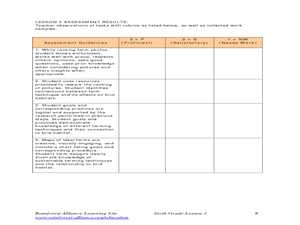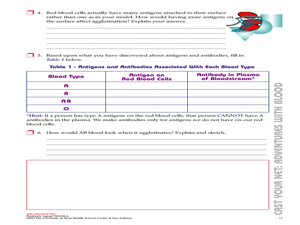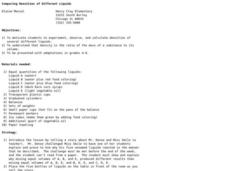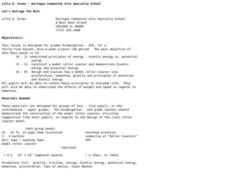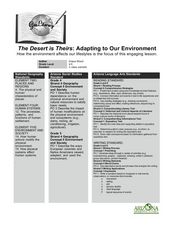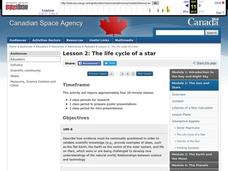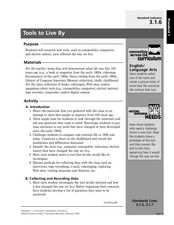EngageNY
Magnitude
Build an understanding of the powers of 10. Pupils investigate the results of raising 10 to positive and negative powers. They relate this understanding to the magnitude these powers represent in this seventh lesson of 15.
Curated OER
Inquiry into Consumer Products
Students recognize different consumer products, found in and around the home, that have reactive or denaturing properties when used together. They explore chemical and physical properties of each product by identifying chemical formulas...
Davis School District
Computer Parts
What is inside a computer? Give your budding computer scientists a worksheet that has them label parts of a computer. They use a link included on the sheet to label basic input/output systems, video cards, drives, case fan, and more....
Curated OER
How can my breakfast help the birds?
Sixth graders design farms with a bird's habitat in mind. In this farm lesson plan, 6th graders research how sun grown coffee destroys a bird habitat, and then they make their own farm with a bird's habitat being preserved. They then...
Curated OER
Antibody Center Template
In this antibodies worksheet, learners use model diagrams of antigens, antibodies and blood cells to develop a visual understanding of the immune system. They draw diagrams of antibodies and antigens attached to each other and answer...
Curated OER
A Bug's Life: Diary of an Insect's Metamorphosis
Fifth graders examine the stages of insect's to understand heredity. In this inherited traits lesson plan, 5th graders explore the life of the honeybee for its inherited traits. Students recognize the difference between inherited...
Curated OER
Creeping and Crawling Observing Mealworms and Earthworms
Young scholars observe the inherited traits in earthworms and mealworms. In this organisms lesson, students view a live mealworm and earthworm on a tray and identify the body parts. Young scholars measure the worms and observe the...
Curated OER
Comparing Densities of Different Liquids
Students experiment with a variety of liquids to calculate density. In this integrated science and math lesson, students listen to a story in which the characters must prove and explain why 5 "mystery" liquids react in a certain manner....
Curated OER
Hand Washing: I can handle it!
Sixth graders examine microorganisms. In this germs instructional activity, 6th graders observe and record data on the positive and negative aspects of microorganisms. Students complete activities, view a film, and explore...
Curated OER
Modeling the Big Bang and the Formation of the Universe
Sixth graders conduct an experiment to understand the Big Bang Theory. In this Big Bang Theory lesson plan, 6th graders will observe a balloon with confetti popping to emulate and analyze information related tot he Big Bang theory....
Curated OER
Let's Outrage the Bull
Students study kinetic and potential energy. In this energy lesson, students in grades K-2 understand the differences between kinetic and potential energy. Students in grades 3-5 demonstrate that kinetic and potential energy. Students in...
Curated OER
The Desert is Theirs: Adapting to Our Environment
Students determine how animals and people adapt to the desert environment. In this desert lesson, students review vocabulary about the desert and how humans have to make changes to accommodate their environments. They listen to and...
Curated OER
Soil is a Filter
Students examine how to take the impurities out of eater. In this exploratory lesson students complete an experiment on how to filter drinking water.
Curated OER
In Search of the Giant Squid
Young scholars examine the giant squid and its habitat. In this giant squid lesson, students discover the size, behavior, and natural habitat of the giant squid. Activities range from scientific information to myths and folklore. Young...
Curated OER
Amazing Grazing: Keeping Our Ecosystem Running
Learners discover the value of sustainability within our ecosystem. In this ecological lesson, students discuss the importance of a food cycle in our society, and how humans can improve the conservation of a healthy ecosystem. Eventually...
Curated OER
The Life Cycle of a Star
Students investigate the life cycle of a star and make conclusions based on evidence, research, and observation. In this lesson on space and scientific investigation, students describe the relationships between science and...
Curated OER
What are Stars?
Students research the solar system and it's characteristics. For this solar system lesson, students are broken into 4 groups, each assigned a specific part of the solar system. Students use the Internet to research their part...
Curated OER
Tools to Live By
Third graders compare life in the early 1900's with the life today. In this technology lesson, 3rd graders research about the development of a certain technological tool. They collect data and report findings in class.
Curated OER
Agriculture Pays
Second graders role play one of the jobs related to agriculture and explain their role in getting one of the five "f's" of agriculture to the consumer. In this agriculture activity, 2nd graders are assigned a role and a...
Curated OER
Paint's Family Tree
Students sort and classify the genetic traits of horses. In this heredity and genetics instructional activity, students read dialogue in a skit in which specific physical traits of several horses are described and a horse family tree is...
Curated OER
Fire Safety in the Home
Students discover the importance of fire safety. In this fire prevention lesson, students identify problems in a house that could lead to a fire and draw their own homes that include the appropriate fire prevention tools. The students...
Curated OER
Rocks on Parade!
Third graders describe and classify rock samples. In this rock lesson, 3rd graders make inferences about rock samples by observing and measuring them. This lesson contains 5 different stations for the students to go to.
Curated OER
Gone But Not Forgotten
Third graders examine animals and organisms that have become extinct and their similarities to living organisms. In this extinction lesson students divide into groups and research extinct animals.
Curated OER
Light and Optics
Third graders utilize the scientific method to explain light and optics in this five lessons unit. Through experimentation and discussion, 3rd graders canvass the concepts of light traveling, reflection and refraction.



